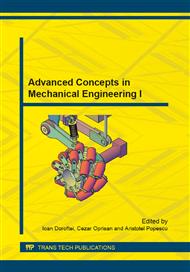[1]
A. Morassi, F. Vestroni, Dynamic Methods for Damage Detection in Structures, Springer, (2008).
Google Scholar
[2]
S. W. Doebling, C. R. Farrar, M. B. Prime, D. Shevitz, Damage Identification and Health Monitoring of Structural and Mechanical Systems From Changes in their Vibration Characteristics: A literature Review, Los Alamos National Laboratory Report LA-13070-MS, (1996).
DOI: 10.2172/249299
Google Scholar
[3]
J. Kullaa, Distinguishing between sensor fault, structural damage, and environmental or operational effects in structural health monitoring, Mechanical Systems and Signal Processing, 25 (2011) 2976–2989.
DOI: 10.1016/j.ymssp.2011.05.017
Google Scholar
[4]
G. -R. Gillich, Z. Praisach, D.M. Onchis, About the effectiveness of damage detection methods based on vibration measurements, International Conference on Engineering Mechanics, Structures, Engineering Geology, International Conference on Geography and Geology - Proceedings, 2010, pp.204-209.
Google Scholar
[5]
G. Park, H. Sohn, C. R. Farrar, D. J. Inman, Overview of Piezoelectric Impedance-Based Health Monitoring and Path Forward, Shock and Vibration Digest, 35 (2003) 451–463.
DOI: 10.1177/05831024030356001
Google Scholar
[6]
H. Guo, G. Xiao, N. Mrad, J. Yao, Fiber Optic Sensors for Structural Health Monitoring of Air Platforms, Sensors, 11 (2011) 3687-3705.
DOI: 10.3390/s110403687
Google Scholar
[7]
J.V. Araújo dos Santos, N.M.M. Maia, C.M. Mota Soares, C.A. Mota Soares, Structural Damage Identification: A Survey, in: B.H.V. Topping, M. Papadrakakis (Eds. ), Trends in Computational Structures Technology, Saxe-Coburg Publications, Stirlingshire, 2008, pp.1-24.
DOI: 10.4203/csets.19.1
Google Scholar
[8]
Y. -Z. Song, C.R. Bowen, H.A. Kim, A. Nassehi, J. Padget, N. Gathercole, A., Non-invasive damage detection in beams using marker extraction and wavelets, Mech. Syst. Signal Process. (2014).
DOI: 10.1016/j.ymssp.2013.12.011
Google Scholar
[9]
S.W. Doebling, C.R. Farrar, M.B. Prime, A summary review of vibration-based damage identification methods, Shock and Vibration Digest, 30 (1998) 91-105.
DOI: 10.1177/058310249803000201
Google Scholar
[10]
M.I. Friswell, Damage identification using inverse methods, Phil. Trans. R. Soc. A, 365 (2007) 393-410.
Google Scholar
[11]
A. Rytter, Vibration based inspection of civil engineering structures. Ph.D. Thesis, Aalborg University, Denmark, (1993).
Google Scholar
[12]
G.R. Gillich, Z.I. Praisach, Robust method to identify damages in beams based on frequency shift analysis, Proceedings of SPIE - The International Society for Optical Engineering 8348, San Diego, art. no. 83481D, (2012).
DOI: 10.1117/12.915158
Google Scholar
[13]
G.R. Gillich, Z.I. Praisach, Damage-patterns based method to locate discontinuities in beams, Proceedings of SPIE - The International Society for Optical Engineering 8695, art. no. 869532, (2013).
DOI: 10.1117/12.2009122
Google Scholar
[14]
P.F. Minda, Z.I. Praisach, N. Gillich, A.A. Minda, G.R. Gillich, On the efficiency of different dissimilarity estimators used in damage detection, Romanian Journal of Acoustics and Vibration, 10 (2013) 15-18.
DOI: 10.4028/www.scientific.net/amm.430.84
Google Scholar


